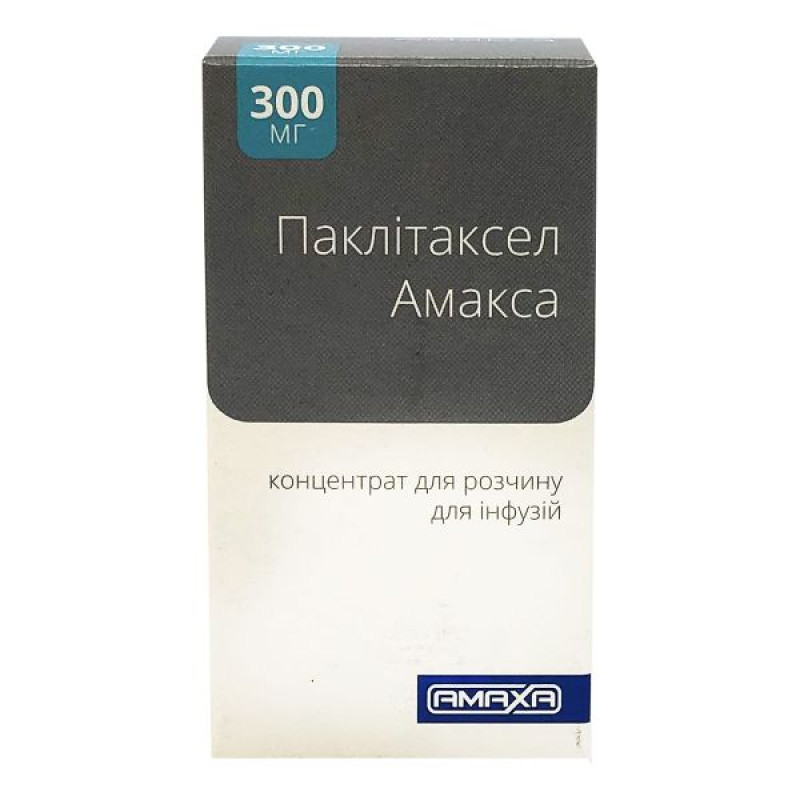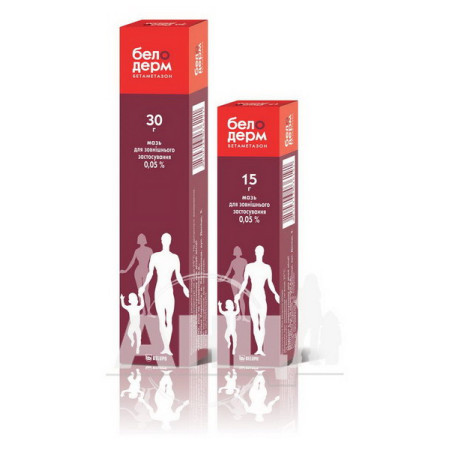Paclitaxel Amaxa concentrate for solution for infusion 6 mg/ml, 300 mg vial, 50 ml No. 1

Paclitaxel Amaxa concentrate for solution for infusion is used for the indications listed below.
Ovarian cancer:
as a first-line drug for the treatment of ovarian cancer, as well as in combination with cisplatin for advanced ovarian cancer or for residual tumors larger than 1 cm after laparotomy; as a second-line drug for the treatment of metastatic ovarian cancer, if standard therapy with platinum drugs has been ineffective.Breast cancer:
as an adjunct to the treatment of patients with lymph node involvement after standard combination therapy with anthracyclines or cyclophosphamide; primary treatment of locally advanced or metastatic breast cancer, as monotherapy or in combination with anthracyclines or trastuzumab, in case of immunohistochemically detected overexpression of HER-2 oncoproteins (3+) or in the presence of contraindications to anthracycline therapy; monotherapy of metastatic breast cancer after ineffective standard therapy.Progressive non-small cell lung cancer: combination chemotherapy with cisplatin if surgical treatment and/or radiotherapy are not possible.
Kaposi's sarcoma (KS) in AIDS patients: in case of ineffectiveness of previous therapy with liposomal anthracyclines.
Composition
The active substance is paclitaxel (1 ml of concentrate contains 6 mg of paclitaxel).
Excipients: polyethoxylated castor oil, citric acid, anhydrous ethanol.
Contraindication
Hypersensitivity to paclitaxel or other components of the drug (especially to polyethoxylated castor oil); neutropenia (initial neutrophil count <1.5 × '10 9 / l, in the case of Kaposi's sarcoma in AIDS patients - neutrophil count <1 × '10 9 / l), thrombocytopenia (<100 × '10 9 / l); concomitant severe uncontrolled infections in patients with Kaposi's sarcoma; severe liver dysfunction; pregnancy and breastfeeding.Method of application
The concentrate for solution for infusion must be diluted before use and administered intravenously. All patients should receive premedication with corticosteroids, antihistamines, and H2-receptor antagonists prior to initiation of paclitaxel treatment.
Paclitaxel Amax should be administered through an in-line filter with a microporous membrane ≤ 0.22 μm.
Ovarian cancer (as a first-line drug)
A combination treatment regimen is recommended.
Two doses of paclitaxel are recommended according to the duration of the infusion:
Paclitaxel at a dose of 175 mg/m2 should be administered by intravenous infusion over 3 hours, then cisplatin at a dose of 75 mg/m2; the interval between treatment courses is 3 weeks; Paclitaxel at a dose of 135 mg/m2 should be administered as a 24-hour intravenous infusion, then cisplatin at a dose of 75 mg/m2; the interval between treatment courses is 3 weeks.Ovarian cancer (as a second-line drug)
The recommended dose of paclitaxel is 175 mg/m2 administered by intravenous infusion over 3 hours. A total of 4 courses are recommended with an interval of 3 weeks between courses.
Breast cancer (adjuvant chemotherapy for breast cancer)
The recommended dose of paclitaxel is 175 mg/m2 administered by intravenous infusion over 3 hours. 4 courses of treatment are given, with an interval of 3 weeks between courses. Administer after anthracycline or cyclophosphamide therapy.
Breast cancer (as a first-line drug)
When used in combination with doxorubicin (50 mg/m2), paclitaxel should be administered 24 hours after doxorubicin. The recommended dose of paclitaxel is 220 mg/m2, administered by intravenous infusion over 3 hours. The interval between courses is 3 weeks.
When used in combination with trastuzumab, the recommended dose of paclitaxel is 175 mg/m2 administered by intravenous infusion over 3 hours. The interval between courses is 3 weeks. Paclitaxel infusion can be started 24 hours after the first dose of trastuzumab or immediately after subsequent doses of trastuzumab if the previous dose of trastuzumab was well tolerated.
Breast cancer (as a second-line drug)
The recommended dose of paclitaxel is 175 mg/m2 administered by intravenous infusion over 3 hours. The interval between courses is 3 weeks.
Treatment of non-small cell lung cancer
The recommended dose of paclitaxel is 175 mg/m2, administered by intravenous infusion over 3 hours, followed by cisplatin at a dose of 80 mg/m2. The interval between courses is 3 weeks.
Treatment of Kaposi's sarcoma in AIDS patients
The recommended dose of paclitaxel is 100 mg/m2 administered by intravenous infusion over 3 hours every two weeks.
Subsequent doses of paclitaxel should be adjusted according to individual patient tolerability.
Repeated administrations are possible only after the number of neutrophils has increased to a level of ≥ 1.5 × '10 9 / l (≥ 1 × '10 9 / l for patients with Kaposi's sarcoma) and platelets to a level of ≥ 100 × '10 9 / l (≥ 75 × 10 9 / l for patients with Kaposi's sarcoma). In patients who have experienced severe neutropenia (the number of neutrophils was below 0.5 × '10 9 / l for 7 days) or severe peripheral neuropathy, subsequent doses should be reduced by 20% (for patients with Kaposi's sarcoma - by 25%).
Application features
Children
The safety and efficacy of paclitaxel in children have not been established. It is not recommended for use in this category of patients.
Paclitaxel contains alcohol, so the ability to drive or use machines may be impaired due to the alcohol content of the medicinal product.
Overdose
Symptoms: bone marrow suppression, peripheral neuropathy, inflammation of the mucous membranes.
Treatment: in case of overdose, the drug should be discontinued immediately and symptomatic treatment should be carried out with monitoring of the content of formed blood elements and the state of vital organ functions. The antidote to paclitaxel is unknown.
Side effects
The most common adverse reaction with paclitaxel is bone marrow suppression. Severe neutropenia (<0.5 × 109/L) was observed in 28% of patients, but no cases of fever were reported. Only 1% of patients experienced severe neutropenia for ≥ 7 days. Thrombocytopenia was observed in 11% of patients. In 3% of patients, the platelet count was <50 × 109/L at least once during this study. Anemia was observed in 64% of patients, but it was severe (Hb <5 mmol/L) in only 6% of patients. The incidence and severity of anemia are related to baseline hemoglobin values.
Storage conditions
Store in the original packaging to protect from light at a temperature not exceeding 25 °C, out of the reach of children.
Shelf life - 3 years.
After opening the bottle: from a microbiological, chemical and physical point of view, this product can be stored for 28 days at a temperature not exceeding 25 ° C. The consumer is responsible for the duration of storage and storage conditions of the product after opening the bottle.
After dilution: The diluted solution for infusion has been shown to be chemically and physically stable for 72 hours at temperatures not exceeding 25°C.
Diluted solutions should not be stored in the refrigerator.
From a microbiological point of view, the diluted solution should be used immediately.
There are no reviews for this product.
There are no reviews for this product, be the first to leave your review.
No questions about this product, be the first and ask your question.










